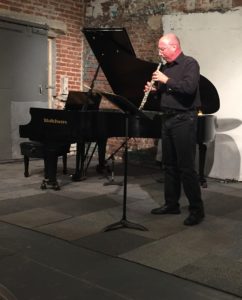 Tuesday, September 19, 2017 saw the first concert of the season at Monk Space, and for this occasion Luciano Berio’s challenging Sequenza series of virtuoso pieces were performed by the top musicians in Los Angeles. The event was also a fund-raiser to support new music at Monk Space with the musicians generously donating their time and talents for this extraordinary concert. A full crowd wedged itself into the cozy spaces of the Koreatown venue to hear, as the poet Edoardo Sanguineti wrote “…the sequence of sequences, which is the music of musics according to Luciano.”
Tuesday, September 19, 2017 saw the first concert of the season at Monk Space, and for this occasion Luciano Berio’s challenging Sequenza series of virtuoso pieces were performed by the top musicians in Los Angeles. The event was also a fund-raiser to support new music at Monk Space with the musicians generously donating their time and talents for this extraordinary concert. A full crowd wedged itself into the cozy spaces of the Koreatown venue to hear, as the poet Edoardo Sanguineti wrote “…the sequence of sequences, which is the music of musics according to Luciano.”
Each Sequenza is written for a different instrument and performed solo by a different musician, so to allow for set changes and the length of the program, the concert was held simultaneously in two spaces – the normal Monk Space warehouse and a smaller annex. It was impossible to hear all of the pieces, but everything was timed to allow those in the audience to move between the spaces and hear several different the pieces, even if they were not in the same place. The audience was politely careful to avoid entering or exiting during a performance and so this arrangement worked fairly well. I chose to stay in the warehouse for the first half of the concert and move to the annex after the intermission.
Before each Sequenza a few short lines from a Sanguineti poem were recited by Kirsten Ashley Weist. The first piece heard in the warehouse was Sequenza IV – Piano (1965), performed by Mari Kawamura and this began with a number of short, sharp chords followed by a series of complex phrases. There was no regular beat to follow but rather a chain of intricate and technically demanding passages, sometimes mixed with longer, sustained chords. There is a generally unsettled feeling to this music that often combined with the mysterious and uncertain. The intensity seemed to increase as the piece progressed, but the anxiety was occasionally relieved as the rapid phrases were allowed to ring out and decay into brief silences. Ms. Kawamura was duly focused and her technique proved equal to the difficulties of the score. Sequenza IV, with all its convolutions and complexities is anxious and disquieting music, but this was masterfully realized by Ms. Kawamura’s precisely passionate playing.
Sequenza XIVa (2002) for cello followed, while another version for bass was performed by Tom Peters as part of the program running in the annex. After the introductory lines of poetry, cellist Ashley Walters began Sequenza XIVa with soft drumming on the cello body and some lively pizzicato notes on the open strings. This made for an intriguing combination and it seemed as if there were two players on the stage. Strong arco passages soon followed, producing a somewhat somber feel but rapid strumming on the strings plus a series of rising and falling trills restored the complex character of this piece. Incredible sounds poured from the stage in a series of extended techniques that were variously angry and active, quiet and timid or occasionally warm and smooth. The texture constantly swirled and shifted, never settling for long. Ms. Walters was, however, in complete command of her instrument, extracting all of the colors – and then some – from the cello palette.